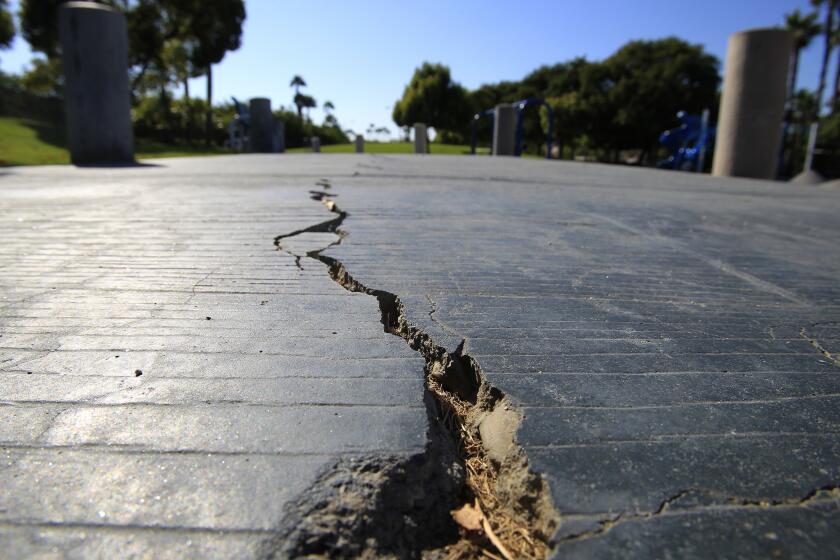A lurking earthquake fault has blocked Hollywood’s tallest building. Will it ever rise?
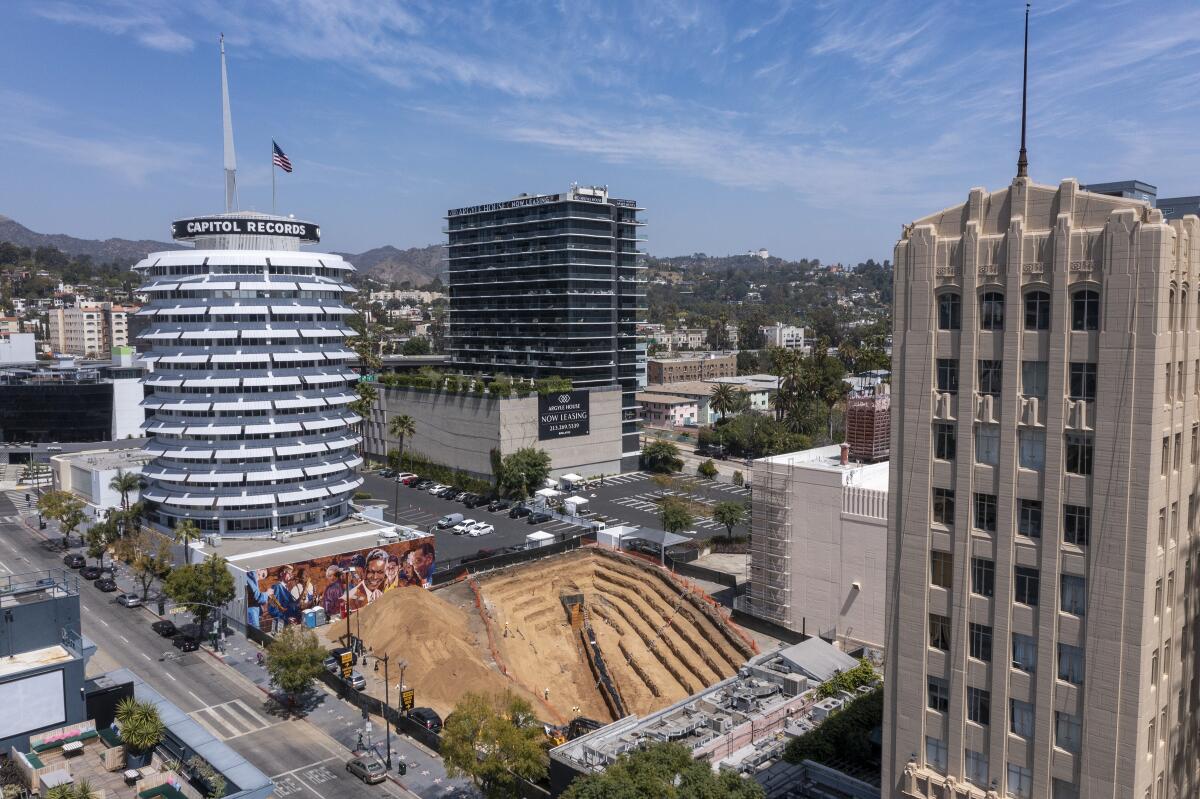
- Share via
When developers announced a decade ago that they intended to build Hollywood’s first skyscrapers along an aging, fading block, boosters saw it as a transformational moment.
Gentrification was already remaking Hollywood with a series of big high-end developments, but this project was different. The complex, which would flank the Capitol Records building north of Hollywood Boulevard and Vine Street, would alter the L.A. skyline and add more than 1 million square feet of office, retail and residential space. Some neighboring residents and others protested, saying the soaring towers would block views, invite horrific traffic and irrevocably alter Hollywood’s character.
But those concerns ended up taking a back seat to a much larger issue: what was lurking under the land.
For eight years, there has been a high-profile argument over whether active earthquake faults run directly under the site of the proposed development, making it too dangerous to build there. The California Geological Survey — the state’s scientific authority on the location of earthquake faults — suggested in 2013 and concluded in 2014 that an active fault capable of generating a magnitude 7 earthquake runs through the site.
These concerns have raised serious questions about what would be Hollywood’s biggest development and pose a major test for City Hall.
In the 50 years since the 6.6 magnitude Sylmar quake, city leaders have alternated between ignoring the risk of earthquakes and enacting sweeping legislation to order that defective buildings be fixed. One of Mayor Eric Garcetti’s earliest policy achievements was the passage of the city’s most consequential earthquake safety laws in a generation, laws that will require thousands of potentially dangerous wooden, soft-story apartment buildings and concrete buildings to be strengthened.
Persuading property owners to pay for this work was seen as a milestone in earthquake policy in California, and one that other cities have followed. Earthquake experts praised Garcetti for building a new political consensus that they say will save lives.
But the proposed Hollywood Center project has offered a different question: Should the city reject a development because the California Geological Survey says it sits on top of an active earthquake fault? Or should the city side with the developer’s consulting geologists, who have disagreed, and allow construction to begin?
A great deal of money, not to mention the potential safety of countless people, is at stake.
The Hollywood fault runs through some of the most densely populated parts of Los Angeles.
For decades, state law has generally banned new construction directly on top of active earthquake faults.
But it’s up to city officials to make the final call as to whether to allow construction to proceed. City officials can legally decide to ignore the conclusions of the California Geological Survey and can instead choose to accept the conclusions of consultants hired by the developer.
There likely hasn’t been such intense controversy over a proposed skyscraper in California history; neither downtown L.A. nor downtown San Francisco has known major active earthquake faults that rupture at the surface.
But other parts of the L.A. region have been here before.
When a fault was discovered below a school site near downtown, officials tore down a portion of the new school and reserved the area over the fault as a park. Buildings found to be on top of faults at Los Angeles Southwest College and San Bernardino Valley College have been razed; a shopping center in Huntington Beach was demolished and rebuilt to avoid a fault. And in a suburb of Long Beach, developers took painstaking care to avoid building new homes atop a fault in Signal Hill, and instead put a road, tennis courts, and parking lots atop or around the fault.
“You just don’t put someone’s bedroom on top of a fault. There’s a legal issue, but also a moral issue there,” a developer of the Signal Hill neighborhood told The Times in 2014.
California’s state geologist has concluded that an active earthquake fault is underneath a massive proposed skyscraper project in Hollywood, setting the stage for a huge battle at City Hall over growth and seismic safety.
The stakes in Hollywood are higher. The New York-based developer, Millennium Partners, and Los Angeles City Hall have previously rejected the state’s concerns and insisted that the skyscrapers were safe to build. The developer has contended that no earthquake faults under the property have moved since the last Ice Age.
The long debate might finally be coming to a head.
The city has ordered the developer to begin a new effort, by digging a trench to investigate the presence of faults through the site of the proposed project.
The move comes after L.A. city officials and the developer in the fall agreed to put the project on hold after state officials last summer said even more strong evidence had emerged that multiple earthquake faults run through the site.
Formerly known as Millennium Hollywood, the Hollywood Center project envisions the construction of 46- and 35-story skyscrapers, as well as two buildings for low-income senior residents that would each stand 11 stories tall.
The project would place nearly 1.3 million square feet of developed space on about 4½ acres of land, adding more than 1,000 residential units and more than 30,000 square feet for retail and restaurant use. An alternate plan would involve creating more than 880 housing units and a 220-room hotel.
Thousands of people could be inside the development at any time, according to the project’s environmental impact report.
There has been growing evidence in recent years that the fault runs under the property, including from data in reports published last year by federal and state scientists.
“These studies strongly support the presence of an active ... fault strand entering the eastern Hollywood Center property,” said a letter last summer by the California Geological Survey. “Importantly, the combined data indicate that more than one ... fault trace of the Hollywood Fault crosses the proposed project site.”
The state also noted a recent U.S. Geological Survey report that found four parallel sections of the Hollywood fault identified just east of the property that are believed to extend under the development.
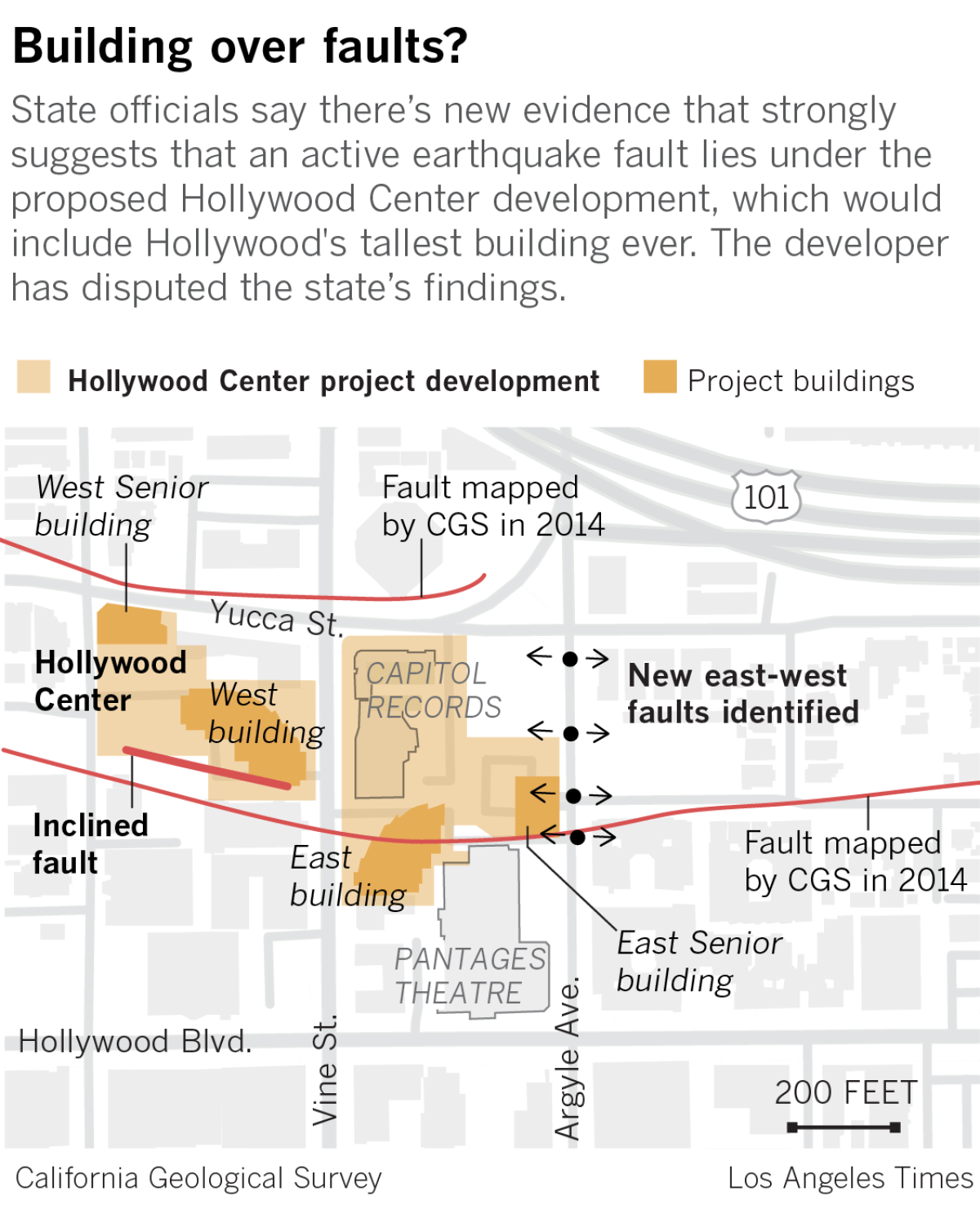
The California Geological Survey has said there were limitations in previous studies cited by the developer as evidence of the absence of a fault. For instance, the state agency said a fault trench excavated in 2014 was not dug long enough for the developer to disprove the state’s conclusion that an active fault ran underneath the property.
Shortly after the state’s letter emerged in July, city officials began moving to slow down the project. A letter last year by Daniel Schneidereit, an engineering geologist with the city, said, “We acknowledge the [California Geological Survey’s] concern and believe the best way to resolve the issue is for the developer to excavate another exploratory trench to demonstrate, or rule out, the presence of an active fault.”
Schneidereit wrote that the city would request that California Geological Survey geologists “observe the trench and verify the exploration results.”
The last permanent head of the California Geological Survey, former state geologist John Parrish, said there were major problems in 2014, when the developer excavated a trench in an effort to settle the question of whether an active fault was present beneath the property. It was as if the trench was dug to avoid finding the fault, said Parrish, who led the California Geological Survey from 2005 to 2018. The trench was not only too shallow but was not dug far enough to the south to confirm or disprove the existence of an active fault line that’s now drawn on the California Geological Survey’s earthquake maps, Parrish said. He added that consultants for the developer rejected his suggestions for a deeper and longer trench and allowed state scientists to visit the trench only once, briefly, and did not allow them to take photographs.
The L.A. Department of Building and Safety in a statement defended the 2014 trench as “adequate to determine the existence of active faults within the area of that trenching.”
The developer’s consultants concluded in 2015 that an earthquake fault was probably located deep beneath the property but said it was too old to be considered active.
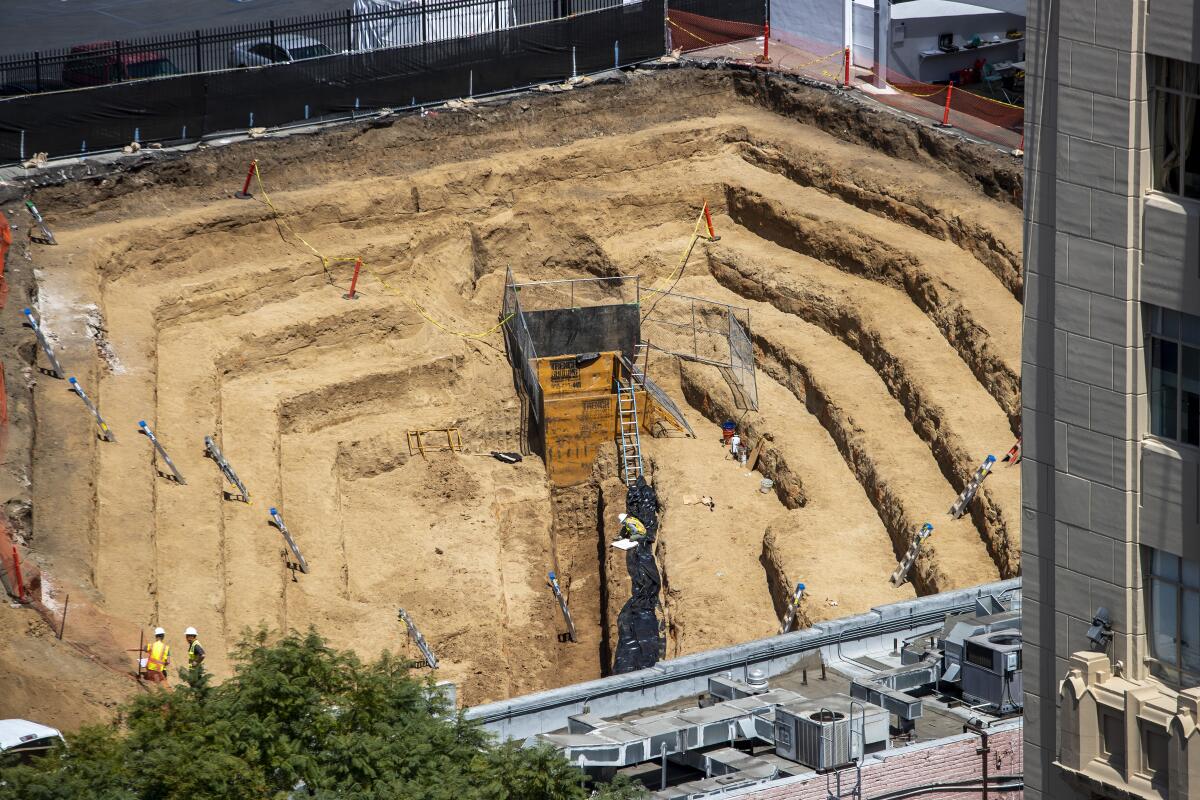
Parrish has raised questions about the developer’s past conclusions, which he said were based on a visual dating technique that is known to be “remarkably inaccurate.” A more precise dating technique would involving taking soil samples to a laboratory for carbon dating. The developer’s consultants took soil samples for carbon dating but declined to make the results publicly available, Parrish said.
“It was very frustrating,” Parrish said of the previous trenching effort. “When we said, ‘They’re not digging deep enough or far enough,’ they said, ‘Don’t come around anymore. You’re not a welcome guest anymore.’”
It’s in the public interest to have a fully excavated trench and invite scientists of all kinds to make their observations, Parrish said, in order to give city officials the best information about the existence of a fault on land that may be developed.
Parrish suggested that the city of Los Angeles ask that two trenches be excavated — one on each side of Vine Street — to look for faults on both parcels where skyscrapers would be constructed. Parrish said they should be dug in a north-south direction, crossing the entire length of the parcel, and must be deep enough to be scientifically useful.
The city is asking only that one trench be excavated, on the eastern parcel. “Trenches on other parts of the site are not needed, as geologic exploration has already determined there are no active faults,” said a statement issued by the Department of Building and Safety.
Such a strategy overlooks concerns expressed by the California Geological Survey over a fault marked last year on a state memo on the western parcel, which as the fault goes deeper underground, is angled farther to the north.
There’s a possibility that, should a skyscraper be built on the western parcel, it would have its foundation on both sides of the Hollywood fault — setting up the building to be destroyed if one side of the fault lurches past the other in a major earthquake, according to Parrish.
Scientists working with the California Geological Survey were not made available for an interview. Jacob Roper, a spokesman for the agency, declined to comment.
A review of correspondence between city and state officials, which The Times conducted of documents released by the city under a Public Records Act request, suggests that city officials are seeking input from the California Geological Survey over how the trench is being dug on the eastern parcel. In one letter to city officials, the state scientists suggested making the trench bigger than originally planned.
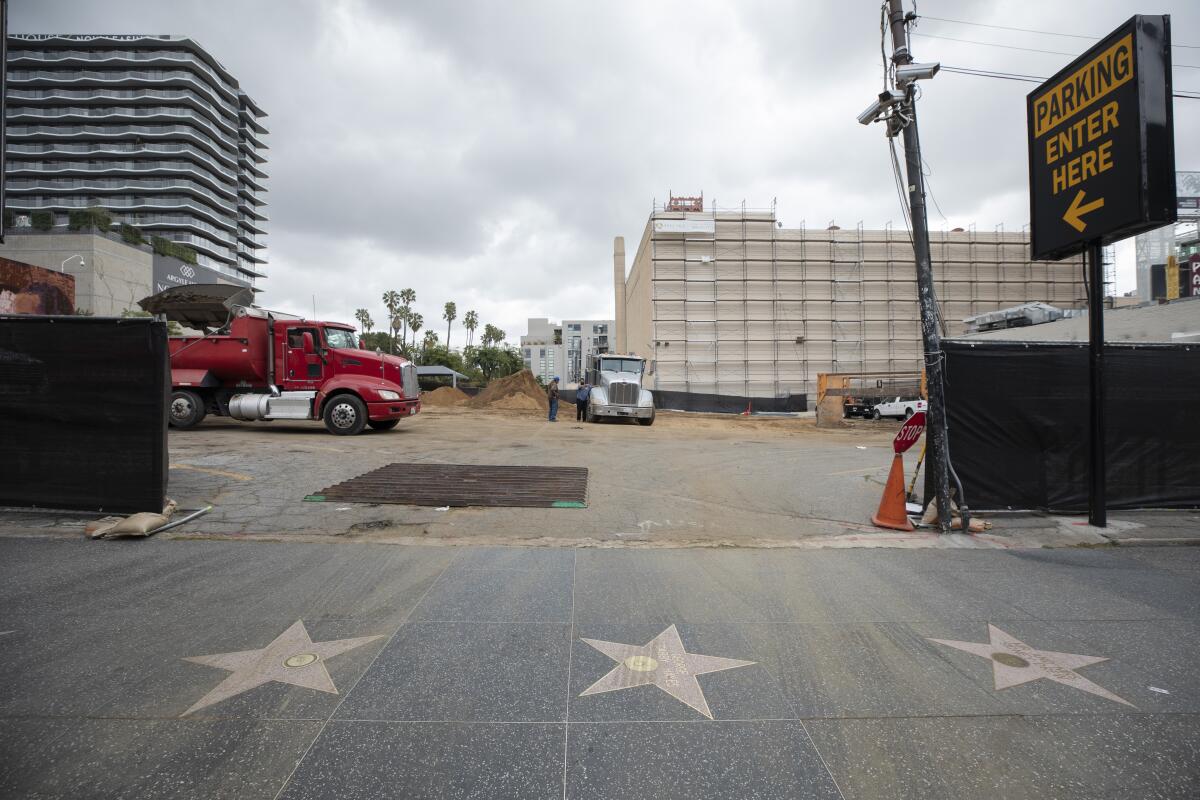
In the same letter, dated March 15, the California Geological Survey said it looks forward to having ample access to the site. “Multiple reviewers with experience in fault investigations and repeated visits are often necessary,” the letter said. It added that the findings from this trench could also affect development on the western parcel.
Robert P. Silverstein, a Pasadena lawyer who represents neighborhood groups opposed to the development, said it is troubling that the city is not ordering the kind of rigorous trenching that was suggested by Parrish.
“This is so disturbing; when there is finally the chance to get to truth and safety, the city is still refusing to require the necessary testing,” Silverstein said. “If the city and Millennium have nothing to hide, then they must trench both sites north to south.” A study that tiptoes around the fault, Silverstein said, is not legitimate.
Millennium’s assertions should be especially scrutinized, Silverstein said, given its construction of a skyscraper in San Francisco that has started to lean and sink. The residents of the 58-story building, Millennium Tower, have blamed the developer for design problems; the developer, in turn, blamed a neighboring construction project for causing the noticeable sinking.
Longtime supporters of the Hollywood Center project have previously characterized the new trench study as one that will definitively answer the question of earthquake faults.
“Additional seismic review will enable decision makers, from the city Planning Commission to the City Council, to evaluate and cast a vote based on the merits of the projects without lingering questions or doubts about fault lines,” said Tony Arranaga, spokesman for Councilman Mitch O’Farrell, whose district includes the development and asked the Planning Commission in October to delay considering the project. The developer agreed to the request for a delay.
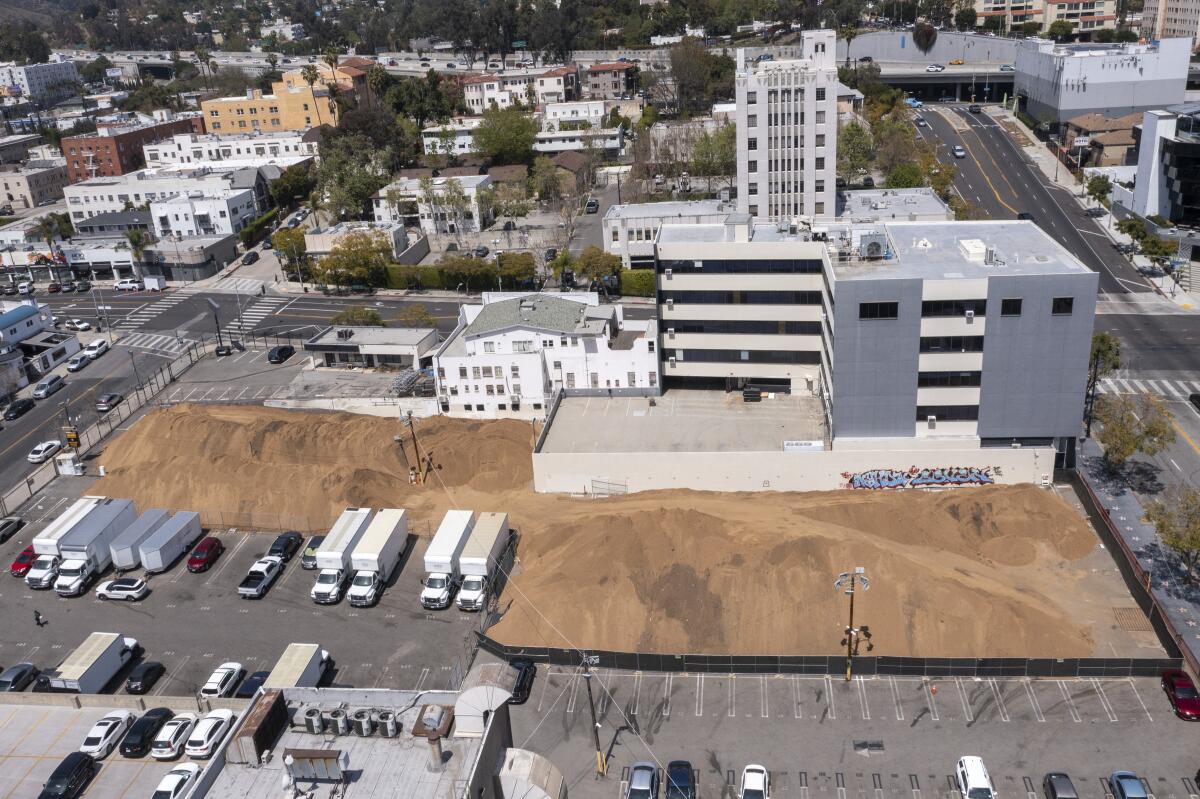
“Doing so will afford the city sufficient time to ensure that our plans for Hollywood Center are consistent with the highest standards of seismic safety,” Mario Palumbo, managing partner of Millennium Partners, said in a statement in October.
On Friday, Dan Halden, a director in O’Farrell’s office, said that while the councilman supported a previous version of the project in 2013, when it was known as Millennium Hollywood, he believes the seismic questions for the Hollywood Center “must be resolved before this project can move forward, and before he could offer his support.”
Last summer, a lawyer for the developer, Edgar Khalatian, sent a letter to the California Geological Survey accusing it of making “false and misleading statements” and of making “a concerted, years-long effort from somewhere within CGS to push a preordained conclusion at the risk of the agency’s reputation and basic scientific principles.”
Garcetti, who has been a champion of new development in Hollywood and has supported the project for years, said he would be guided by his city departments’ analysis of the state scientists’ conclusions and those of the developers. The last time the Department of Building and Safety reviewed the developer’s conclusions in 2015, the agency disagreed with the California Geological Survey and sided with the consulting geologist for the developer.
“I’m going to be guided by not the politics of this, or who wants this, or who doesn’t want it. I’m going to be guided by our city departments — both looking at the state evidence and the evidence of any other seismologists,” Garcetti said late last year.
Times staff writer Rosanna Xia contributed to this report.
More to Read
Sign up for Essential California
The most important California stories and recommendations in your inbox every morning.
You may occasionally receive promotional content from the Los Angeles Times.
